Thanks to the James Webb Space Telescope (JWST), an international team of astronomers has discovered a previously unknown cold brown dwarf. Its mass exceeds the mass of Jupiter by 31 times.
What is a brown dwarf
Brown dwarfs are objects which masses range from 13 to 80 Jupiter masses. They occupy an intermediate position between giant planets and stars. On the one hand, their mass is not enough for permanent fusion reactions based on hydrogen atoms to “start” in their bowels (because of this, they were called “failed stars”). On the other hand, unlike planets, some reactions involving deuterium and lithium nuclei can still occur inside brown dwarfs. But, by astronomical standards, they last very short, after which the brown dwarfs gradually cool down.

First brown dwarf found by James Webb
The newly found JWST brown dwarf was identified during the Through the Looking GLASS project aimed at studying the galactic cluster Abell 2744. It received the designation GLASS-JWST-BD1.

GLASS-JWST-BD1 is located at a distance of 1,850 to 2,350 light-years from Earth in a direction perpendicular to the plane of the Milky Way. Most likely, it is part of the galactic halo. The mass of the object is 31 times the mass of Jupiter, and the age is estimated at 5 billion years.
According to JWST, the effective surface temperature of GLASS-JWST-BD1 is only 330 °C. Thus, it belongs to a rather rare spectral class T. Although many brown dwarfs have been discovered to date, T-dwarfs are relatively rare. At the moment, only about 400 such objects have been identified.
According to the researchers, in the future they intend to conduct additional observations to confirm that GLASS-JWST-BD1 belongs to the T-class. But in any case, the discovery clearly demonstrates the ability of JWST to explore distant low-mass stellar and substellar objects.
You can also read about how James Webb photographed the most distant star in the universe.
According to https://phys.org
Follow us on Twitter to get the most interesting space news in time
https://twitter.com/ust_magazine
